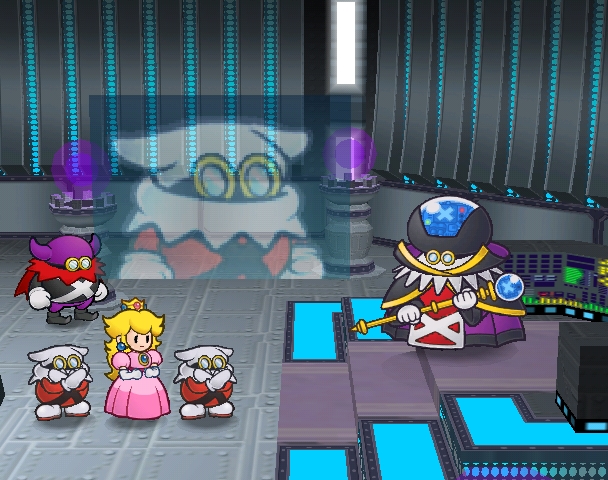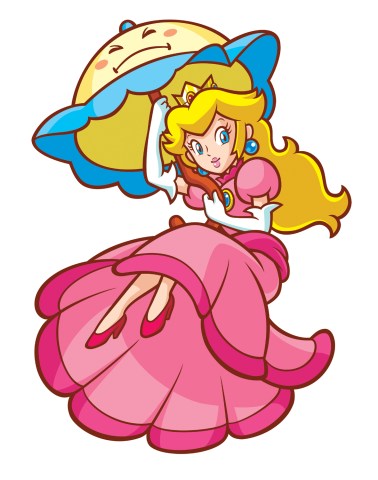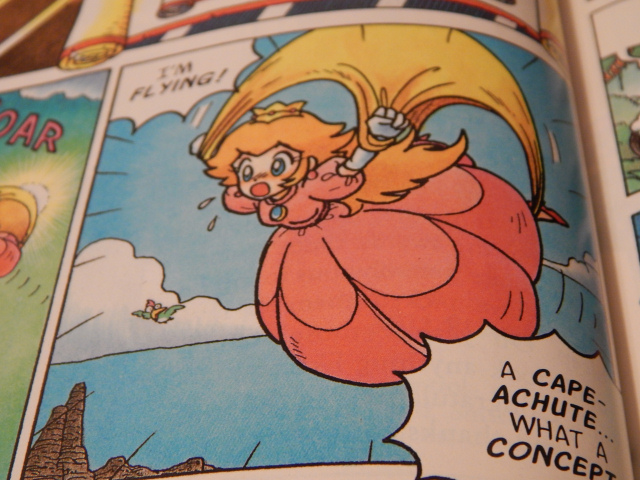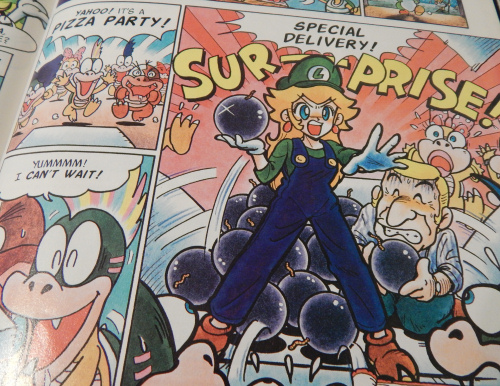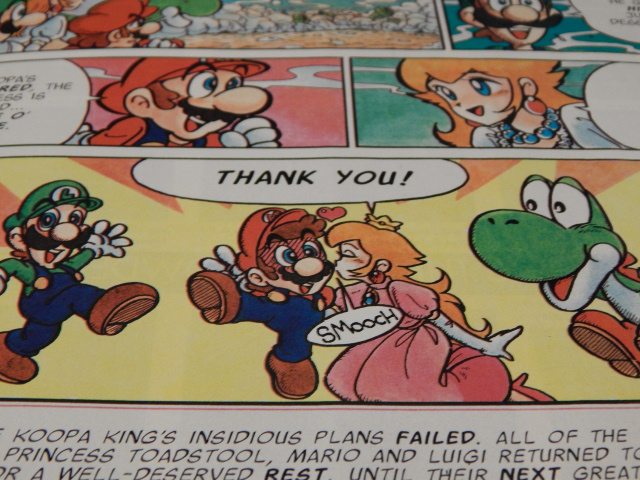The Secret Heroine of Video Games: Princess Peach
That's Princess Toadstool to you, mister.
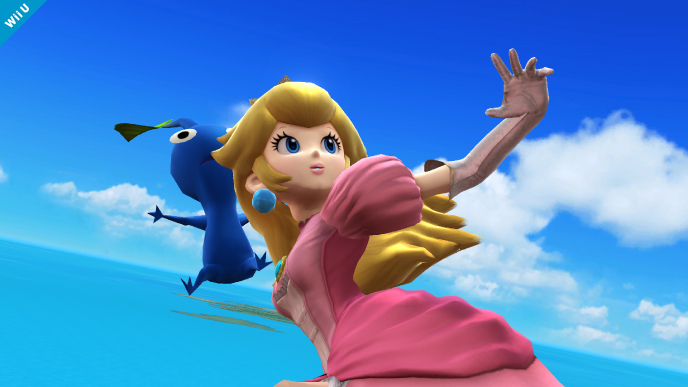
Paper-thin personality
The Paper Mario games were a little kinder. In the first Paper Mario, which was released for Nintendo 64 in 2001 from developer Intelligent Systems, Peach teamed up with a star named Twink in segments separate from Mario’s side of the story. She even participates in a battle against Kammy Koopa, a female villain—even though it’s just to provide support to Twink, who does all the real work in the match.
Paper Mario: The Thousand-Year Door for GameCube (2004) was a favorite of mine. Like in the previous game, Peach gets her own playable moments. Of course, she’s been kidnapped by the evil X-Nauts, but instead of remaining idle, she starts investigating her prison surroundings. She talks to a computer named TEC, which has fallen in love with her, and solves a few puzzles. It’s not much, but it’s nice to see a smarter side to the often airheaded princess.
Super Paper Mario for Wii (2007) even made her a playable character with a bigger role and her own abilities. She fights bosses with her parasol and can float long distances like in Super Mario Bros. 2. As in Super Mario Adventures, she rejects the idea of a forced marriage to Bowser (going so far as to call her wedding dress ugly) though she’s still kidnapped during the course of the game.
Unfortunately, 2012’s Paper Mario: Sticker Star for 3DS discredits the series’ notable track record by reducing Peach to a silent character until the end. Only the idea behind Superstar Saga, an entry in the Mario & Luigi role-playing game series, is more offensive. In it, Peach literally has her voice stolen.
The controversial Super Princess Peach
Another developer outside of Nintendo to give Peach more attention was TOSE, which in 2006 gave her the only starring role she’s ever had in Super Princess Peach for Nintendo DS. The title has received a fair share of criticism, though, as its main gameplay mechanic is overly gendered. As Anita Sarkeesian points out in a Feminist Frequency video, they’re her “mood swings”: joy, rage, gloom, and calm vibes. “That’s right,” she says. “Peach’s powers are her out-of-control, frantic female emotions.”
Not everyone views the game as negative. Despite the narrative scenes being more about her umbrella Perry than her, Peach is (finally) in a lead role. She gets to platform and attack enemies like Mario would, and as one writer observed, her emotions aren’t erratic. She’s the only character in the game that can actually control them. She takes ownership over her feelings to solve puzzles and ultimately rescue her friends.
Both perspectives are valid, but my own problem with the game is less with Peach and more with the treatment of its intended audience: young girls. Super Princess Peach is notably easier than other Mario games (Peach’s joy power makes it nearly impossible to die), but the greatest insult is that Perry tells the player how to defeat each boss before you even have a chance to try. Presumably, this is because girls can’t play games and they need extra help figuring them out. As if girls didn’t do just fine playing the original Super Mario Bros. games decades ago—as a certain princess and I know very well.
A real power player
Using her smarts, controlling her emotions, and helping her friends are all endeavors that Peach makes throughout the Super Mario Bros. comic. And like in the Paper Mario series, she doesn’t sit around idle in captivity. Once she’s been kidnapped by Bowser, Peach tricks the Koopa Kids into opening her cell door while she’s perched up in the corner of the ceiling like a ninja. She jumps down, kicks them in the face with her high heels, and flees to the top of the tower.
Bowser wants her to behave like a docile, motherly bride-to-be, but as she finds herself trapped, Peach throws pillows, dishware, and everything else she can grab at her enemies and even threatens to shred Koopa Kid Wendy’s favorite dress to pieces if she stands in her way. Cornered, Peach snatches a yellow cape and falls out the window—the same yellow cape that Mario uses as a parachute power-up in his games. She even figures out how to use it, though Mario speeding by on a Bullet Bill causes her to spin out of control and crash to the ground. (Good job, Mario.)
With Peach knocked unconscious, what happens next is even more interesting. Seeing Friendly Floyd selling cosmetics to a vain Piranha Plant, Luigi gets the idea to swap clothing with Peach (like he hasn’t been planning that for forever) and infiltrate the castle to save Mario, who is now captive. When Peach awakens, she finds herself dressed in his blue and green overalls and decides to go save Mario herself when Toad explains that doing so would spoil Luigi’s plan.
Luigi, apparently, has decided to play the part of the helpless, love-stricken damsel who’s more than willing to marry Bowser and coddle his children by ordering them a pizza as a sign of maternal adoration. When they open the door, though, an incognito Toad and Yoshi greet them with the steaming delivery, and out pops Peach from the pizza box.
No, not in the sexy, “naked lady popping out of a cake” way. In the “I’m going to blow this place sky-high” way.
This is by far my favorite moment of the comic. Peach, bomb in hand, in Luigi’s outfit, is surrounded by a pile of bombs and the terrified Koopalings. Next to her is Floyd, crouched down on his knees, struggling to lift a single bomb. Because Peach has the strength of a hundred Toads and is awesome like that.
The recap for the next issue (No. 7) calls her “always a woman of action.”
What happens in the next six issues gets even more ridiculous. Luigi, Toad, Yoshi, and Peach band together to rescue Mario, but the adventure is far from over. She winds up kidnapped again and then disappears until a few issues later, when she once more refuses to marry Bowser. Like in Super Paper Mario, Kammy puts her under a spell to get her to cooperate. In the end, she snaps out of her hypnosis and unties Mario (who’s been captured again). An army of Yoshis that Luigi freed chases Bowser through his monstrous wedding cake, which collapses on top of him in an avalanche of frosting and green pipes.
The “happy” ending
Although at times, Mario did the least work of anyone—Luigi and Peach, especially, showed ingenuity, and the characters all worked as a team—he still gets the credit and the kiss in the final panel. Maybe that’s just how Mario adventures have to end. Like in Super Princess Peach, though the princess did the legwork, Mario still catches her in his arms and they share a smooch, making him out to be the bigger hero.
It shouldn’t be that way. This Peach is a hero in her own right—who rescues her friends, wins her own battles, and rejects predetermined gender roles. Though it’s nice to see Peach be a “woman of action” in games like Mario Kart, Super Mario 3D World, and Super Smash Bros., making her a playable character in these games isn’t good enough. She needs wits, depth, and an adventure of her own.
I’m just waiting for the day when she shows up in overalls again, ready to blow the Koopa Kingdom to smithereens.
Stephanie Carmichael writes about video games, comics, and books when she’s not helping teachers and students have fun together with Classcraft, an educational RPG. Find her on her blog or on Twitter.
All screenshots credited to Nintendo of America
Photography: Stephanie Carmichael
Super Mario Adventures written by Kentaro Takekuma, illustrated by Charlie Nozawa, and printed in Nintendo Power magazine.
- Hyrule Warriors Guidebook Shows Unused Character Designs For Female Link
- Tropes vs. Women in Video Games
- Ubisoft Announces Assassin’s Creed DLC Starring a Woman From 16th Century China
Are you following The Mary Sue on Twitter, Facebook, Tumblr, Pinterest, & Google +?
Pages: 1 2
Have a tip we should know? [email protected]
